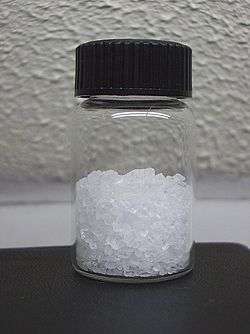Sodium thiosulfate
 | |
 | |
 | |
| Names | |
|---|---|
| IUPAC name
Sodium thiosulfate | |
| Other names
Sodium hyposulfite Hyposulphite of soda | |
| Identifiers | |
| 7772-98-7 10102-17-7 (pentahydrate) | |
| 3D model (Jmol) | Interactive image |
| ChEBI | CHEBI:132112 |
| ChEMBL | ChEMBL2096650 (pentahydrate) |
| ChemSpider | 22885 |
| ECHA InfoCard | 100.028.970 |
| E number | E539 (acidity regulators, ...) |
| PubChem | 24477 |
| RTECS number | XN6476000 |
| UNII | L0IYT1O31N |
| |
| |
| Properties | |
| Na2S2O3 | |
| Molar mass | 158.11 g/mol (anhydrous) 248.18 g/mol (pentahydrate) |
| Appearance | White crystals |
| Odor | Odorless |
| Density | 1.667 g/cm3 |
| Melting point | 48.3 °C (118.9 °F; 321.4 K) (pentahydrate) |
| Boiling point | 100 °C (212 °F; 373 K) (pentahydrate, - 5H2O decomposition) |
| 70.1 g/100 mL (20 °C)[1] 231 g/100 mL (100 °C) | |
| Solubility | negligible in alcohol |
| Refractive index (nD) |
1.489 |
| Structure | |
| monoclinic | |
| Hazards | |
| Safety data sheet | External MSDS |
| R-phrases | R35 |
| NFPA 704 | |
| Flash point | Non-flammable |
| Except where otherwise noted, data are given for materials in their standard state (at 25 °C [77 °F], 100 kPa). | |
| | |
| Infobox references | |
Sodium thiosulfate (Na2S2O3), also spelled sodium thiosulphate, is an inorganic compound that is typically available as the pentahydrate, Na2S2O3·5H2O. The solid is an efflorescent (loses water readily) crystalline substance that dissolves well in water. It is also called sodium hyposulfite or “hypo”.[2]
It is on the World Health Organization's List of Essential Medicines, the most important medications needed in a basic health system.[3]
Uses
Medical uses
- It has been used as treatment of calciphylaxis in hemodialysis people with end-stage kidney disease.[4] There is apparently an incompletely understood phenomenon whereby this causes severe metabolic acidosis in some patients.[5][6]
- It is used as an antidote to cyanide poisoning.[7][8] Thiosulfate serves as a sulfur donor for the conversion of cyanide to thiocyanate (which can then be safely excreted in the urine), catalyzed by the enzyme rhodanase.
- It is used in the management of extravasations during chemotherapy. Sodium thiosulfate prevents alkylation and tissue destruction by providing a substrate for the alkylating agents that have invaded the subcutaneous tissues. The dose may be 2 ml of 0.17 M (a solution of 4 ml 10% sodium thiosulfate and 6 ml sterile water for injection). It may be instilled subcutaneously into multiple sites using a small-gauge needle. Data are limited on this method with few recommendations.
- In foot baths for prophylaxis of ringworm, and as a topical antifungal agent for tinea versicolor.
- In measuring the volume of extracellular body fluid and the renal glomerular filtration rate.[9]
Iodometry
In analytical chemistry, the most important use comes because the thiosulfate anion reacts stoichiometrically with iodine in aqueous solution, reducing it to iodide as it is oxidized to tetrathionate:
- 2 S2O32− + I2 → S4O62− + 2 I−
Due to the quantitative nature of this reaction, as well as because Na2S2O3·5H2O has an excellent shelf-life, it is used as a titrant in iodometry. Na2S2O3·5H2O is also a component of iodine clock experiments.
This particular use can be set up to measure the oxygen content of water through a long series of reactions in the Winkler test for dissolved oxygen. It is also used in estimating volumetrically the concentrations of certain compounds in solution (hydrogen peroxide, for instance) and in estimating the chlorine content in commercial bleaching powder and water.
Photographic processing
Silver halides, e.g., AgBr, typical components of photographic emulsions, dissolve upon treatment with aqueous thiosulfate:
- 2 S2O32− + AgBr → [Ag(S2O3)2]3− + Br−
This application as a photographic fixer was discovered by John Herschel. It is used for both film and photographic paper processing; the sodium thiosulfate is known as a photographic fixer, and is often referred to as 'hypo', from the original chemical name, hyposulphite of soda.[10]
Gold extraction
Sodium thiosulfate is a component of an alternative lixiviant to cyanide for extraction of gold.[11] However, it forms a strong soluble complex with gold(I) ions, [Au(S2O3)2]3−. The advantage of this approach is that thiosulfate is essentially not toxic and that ore types that are refractory to gold cyanidation (e.g. carbonaceous or Carlin-type ores) can be leached by thiosulfate. Some problems with this alternative process include the high consumption of thiosulfate, and the lack of a suitable recovery technique, since [Au(S2O3)2]3− does not adsorb to activated carbon, which is the standard technique used in gold cyanidation to separate the gold complex from the ore slurry.
Neutralizing bleach, chlorinated water, and related treatments
It is used to dechlorinate tap water including lowering chlorine levels for use in aquaria and swimming pools and spas (e.g., following superchlorination) and within water treatment plants to treat settled backwash water prior to release into rivers.[2] The reduction reaction is analogous to the iodine reduction reaction.
In pH testing of bleach substances, sodium thiosulfate neutralizes the color-removing effects of bleach and allows one to test the pH of bleach solutions with liquid indicators. The relevant reaction is akin to the iodine reaction: thiosulfate reduces the hypochlorite (active ingredient in bleach) and in so doing becomes oxidized to sulfate. The complete reaction is:
- 4 NaClO + Na2S2O3 + 2 NaOH → 4 NaCl + 2 Na2SO4 + H2O
Similarly, sodium thiosulfate reacts with bromine, removing the free bromine from solution. Solutions of sodium thiosulfate are commonly used as a precaution in chemistry laboratories when working with bromine and for the safe disposal of bromine, iodine, or other strong oxidizers.
Other
Sodium thiosulfate is also used:
- As a component in hand warmers and other chemical heating pads that produce heat by exothermic crystallization of a supercooled solution.
- In bacteriological water assessment, as it promotes the survival of coliform organisms by neutralizing residual chlorine.[12]:249[13]:572
- In the tanning of leather
- To demonstrate the concept of supercooling in physics classes: Sodium thiosulfate, when heated, dissolves in its own water of crystallisation. This solution can be cooled to room temperature without recrystallisation. When crystallisation is induced by the addition of a small seed crystal, the sudden temperature rise can be experienced by touch.
- As part of patina recipes for copper alloys
- Often used in pharmaceutical preparations as an anionic surfactant to aid in dispersion
Structure
Two polymorphs are known of the pentahydrate. The anhydrous salt exists in several polymorphs.[2] In the solid state, the thiosulfate anion is tetrahedral in shape and is notionally derived by replacing one of the oxygen atoms by a sulfur atom in a sulfate anion. The S-S distance indicates a single bond, implying that the terminal sulfur bears significant negative charge and the S-O interactions have more double-bond character.
Production
On an industrial scale, sodium thiosulfate is produced chiefly from liquid waste products of sodium sulfide or sulfur dye manufacture.[14]
In the laboratory, this salt can be prepared by heating an aqueous solution of sodium sulfite with sulfur or by boiling aqueous sodium hydroxide and sulfur according to this equation:[15]
- 6 NaOH + 4 S → 2 Na2S + Na2S2O3 + 3 H2O
Principal reactions
Upon heating to 300 °C, it decomposes to sodium sulfate and sodium polysulfide:
- 4 Na2S2O3 → 3 Na2SO4 + Na2S5
Thiosulfate salts characteristically decompose upon treatment with acids. Initial protonation occurs at sulfur. When the protonation is conducted in diethyl ether at −78 °C, H2S2O3 (thiosulfuric acid) can be obtained. It is a somewhat strong acid with pKas of 0.6 and 1.7 for the first and second dissociations, respectively.
Under normal conditions, acidification of solutions of this salt excess with even dilute acids results in complete decomposition to sulfur, sulfur dioxide, and water:[14]
- Na2S2O3 + 2 HCl → 2 NaCl + S + SO2 + H2O
This reaction is known as a "clock reaction", because when the sulfur reaches a certain concentration, the solution turns from colourless to a pale yellow. This reaction has been employed to generate colloidal sulfur. This process is used to demonstrate the concept of reaction rate in chemistry classes.
Aluminium cation reaction
Sodium thiosulfate is also used in analytical chemistry. It can, when heated with a sample containing aluminium cations, produce a white precipitate:
- 2 Al3+ + 3 S2O32− + 3 H2O → 3 SO2 + 3 S + 2 Al(OH)3
Organic chemistry
Alkylation of sodium thiosulphate gives S-alkylthiosulfonates, which are called Bunte salts. This reaction is employed in one synthesis of the industrial reagent thioglycolic acid:
- ClCH2CO2H + Na2S2O3 → Na[O3S2CH2CO2H] + NaCl
- Na[O3S2CH2CO2H] + H2O → HSCH2CO2H + NaHSO4
References
- ↑ Record in the GESTIS Substance Database of the IFA
- 1 2 3 J. J. Barbera, A. Metzger, M. Wolf "Sulfites, Thiosulfates, and Dithionites" in Ullmann's Encyclopedia of Industrial Chemistry 2012, Wiley-VCH, Weinheim. doi:10.1002/14356007.a25_477
- ↑ "WHO Model List of EssentialMedicines" (PDF). World Health Organization. October 2013. Retrieved 22 April 2014.
- ↑ Cicone JS, Petronis JB, Embert CD, Spector DA (June 2004). "Successful treatment of calciphylaxis with intravenous sodium thiosulfate". Am. J. Kidney Dis. 43 (6): 1104–8. doi:10.1053/j.ajkd.2004.03.018. PMID 15168392.
- ↑ http://www.medscape.com/viewarticle/762244
- ↑ Selk N, Rodby RA (Jan–Feb 2011). "Unexpectedly severe metabolic acidosis associated with sodium thiosulfate therapy in a patient with calcific uremic arteriolopathy". Semin. Dial. 24 (1): 85–8. doi:10.1111/j.1525-139X.2011.00848.x. PMID 21338397.
- ↑ "Toxicity, Cyanide: Overview - eMedicine". Retrieved 2009-01-01.
- ↑ Hall AH, Dart R, Bogdan G (June 2007). "Sodium thiosulfate or hydroxocobalamin for the empiric treatment of cyanide poisoning?". Ann Emerg Med. 49 (6): 806–13. doi:10.1016/j.annemergmed.2006.09.021. PMID 17098327.
- ↑ "Sodium thiosulfate" at Dorland's Medical Dictionary
- ↑ Charles Robert Gibson (1908). The Romance of Modern Photography, Its Discovery & Its Achievements. Seeley & Co. p. 37.
- ↑ Aylmore, M. G.; Muir, D. M. "Thiosulfate Leaching of Gold - a Review", Minerals Engineering, 2001, 14, 135-174
- ↑ Ralph E. Noble; Oscar Gullans (August 1955). "Influence of sodium thiosulfate on the survival of coliform organisms in stored samples of untreated lake water". Journal of Bacteriology. 70 (2). PMID 13251993. Retrieved 17 November 2015.
- ↑ The Public Health Laboratory Service Water Sub-Committee (December 1953). "The effect of sodium thiosulphate on the coliform and Bacterium coli counts of non-chlorinated water samples". The Journal of Hygiene. 51 (4). PMID 13118158. Retrieved 17 November 2015.
- 1 2 Holleman, A. F.; Wiberg, E. "Inorganic Chemistry" Academic Press: San Diego, 2001. ISBN 0-12-352651-5
- ↑ Gordin, H. M. (1913). Elementary Chemistry, Volume I. Inorganic Chemistry. Chicago: Medico-Dental Publishing Co. pp. 162 & 287–288.
| Wikimedia Commons has media related to Sodium thiosulfate. |
